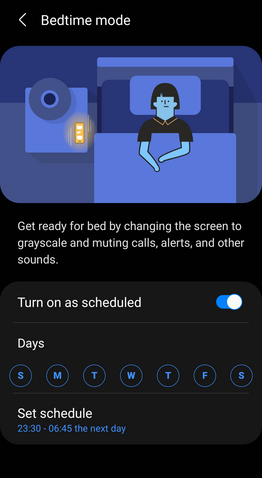Bedtime mode on Android guides you towards better sleep habits by muting notifications and making your phone less interesting. Samsung’s take on the feature says it will mute all sounds and alerts, but that isn’t the whole story. What if you rely on certain notifications and alerts to wake you in the night?
Google requires Android manufacturers to either bundle its Digital Wellbeing app or an equivalent app. Samsung has opted for the latter option with its Samsung Digital Wellbeing app. Samsung’s app has most of the same features as the Google app. However, Samsung’s design doesn’t do as good a job as Google at explaining how its Bedtime mode works.
Bedtime mode, formerly known as Wind Down mode, is a feature that tries to encourage you to put your phone down and go to bed. The mode is enabled on a user-defined schedule. When enabled, it switches the phone’s display to grayscale mode. It also puts the device into Do Not Disturb mode — silencing notifications, vibration, and sound.
However, Samsung’s Digital Wellbeing app doesn’t precisely communicate that it’s using Do Not Disturb mode. The app says Bedtime mode will “mute calls, alerts, and other sounds.” This wording is both precise and vague, and I wasn’t sure how to interpret it. It could mean it mutes all sounds indiscriminately, or that it enables Do Not Disturb mode.
Google’s Digital Wellbeing app clearly communicates that its Bedtime mode uses Do Not Disturb mode. It even offers its customers a toggle switch to turn it off during Bedtime mode. You can see a comparison with Samsung’s app below.


Left/top, Samsung’s single-screen Bedtime mode settings. Right/bottom, Google’s Bedtime mode settings (scheduling on the second screen).
Most Samsung customers won’t have another phone running Google’s variant of Android lying around for reference. Users can’t uninstall Samsung’s Digital Wellbeing app and install Google’s app in its stead either. Samsung’s app documentation doesn’t even mention that Bedtime mode silences the phone. You might do some searches on the web, and discover an article on how Bedtime mode improves your sleep from the Google Blog. You could then assume that Samsung’s Bedtime mode works the same way, but that’s not always a given.
Most notifications should stay quiet throughout the night, and probably won’t be all that important the next day. It makes complete sense to silence them at night. I wanted to use Bedtime mode, but I felt uncertain about how it worked.
So, why does it matter how the phone is silenced? Surely, you just want the damned thing to be quiet at night, right? It gets complicated when you consider app-specific and priority alert exceptions.
Do Not Disturb mode is well-integrated into the notification subsystem and the broader ecosystem. Some wearable devices, like the Samsung Galaxy Fit2, can sync with the phone’s Do Not Disturb and Bedtime modes and adjust its settings accordingly. More importantly, you can configure Do Not Disturb mode to allow priority contacts, repeat calls, and specific apps to break through to alert you.
Some notifications are more important than others. Accidents happen, and repeat calls must be let through even though you don’t want to listen to your drunk friends’ nighttime calls. Maybe you’re on-call and want to still receive a critical alert. Or, maybe you’re wearing a life-extending sensor that, almost unfathomably, is tied to your phone’s notification system.
I wear a glucose sensor that alerts me about critical changes in my diabetes. I get early alerts about hypoglycemic events and can quickly get up out of bed to eat something. It’s like having a diabetes service dog built into my phone! It depends on Android’s notifications system to deliver the alerts, however.
After wasting an hour testing it, I confirmed that Samsung’s Bedtime mode does indeed toggle the Do Not Disturb mode. Notification exceptions created for Do Not Disturb mode also apply to Bedtime mode. If you’re still uncertain about Bedtime mode, then you can schedule Do Not Disturb mode instead (Android 9 and newer).
The only difference between the two scheduled modes is whether or not the screen switches to grayscale mode. Many may find this preferable to Bedtime mode’s turning their displays grayscale. I find grayscale mode frustrating as many apps rely on subtle color queues to communicate important information. (It would seem it has once again become unfashionable to design user interfaces that accommodate the color blind.)
My uncertainty and confusion over how Bedtime mode worked rest entirely on Samsung’s shoulders. It appears like Samsung’s designers haven’t spent the same effort to precisely communicate how Bedtime mode works. Maybe they thought they’d distilled the core functionality of Google’s app, but didn’t fully understand why it was designed the way it is. The app may also have been intentionally made worse to not plagiarize Google’s app. Whatever the reason, Samsung customers don’t get as great an experience as Google customers.
